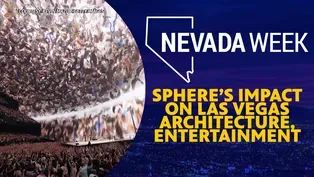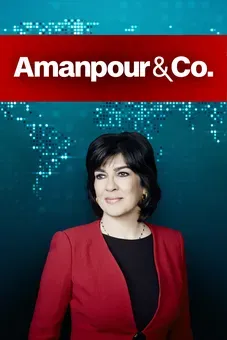
Recap: Nevada Democracy Project’s first Community Listening
Clip: Season 6 Episode 17 | 7m 50sVideo has Closed Captions
Reporter Naoka Foreman shares highlights from Nevada Democracy Project
The Nevada Independent Reporter Naoka Foreman and Amber Renee Dixon share highlights from Nevada Democracy Project’s first Community Listening Session at West Las Vegas Library
Problems with Closed Captions? Closed Captioning Feedback
Problems with Closed Captions? Closed Captioning Feedback
Nevada Week is a local public television program presented by Vegas PBS

Recap: Nevada Democracy Project’s first Community Listening
Clip: Season 6 Episode 17 | 7m 50sVideo has Closed Captions
The Nevada Independent Reporter Naoka Foreman and Amber Renee Dixon share highlights from Nevada Democracy Project’s first Community Listening Session at West Las Vegas Library
Problems with Closed Captions? Closed Captioning Feedback
How to Watch Nevada Week
Nevada Week is available to stream on pbs.org and the free PBS App, available on iPhone, Apple TV, Android TV, Android smartphones, Amazon Fire TV, Amazon Fire Tablet, Roku, Samsung Smart TV, and Vizio.
Providing Support for PBS.org
Learn Moreabout PBS online sponsorshipBut we begin with the Nevada Democracy Project.
It's a partnership between Vegas PBS and The Nevada Independent.
And together, we're holding community listening sessions to find out what we should be reporting on.
We held our first listening session Wednesday at the West Las Vegas Library.
I moderated along with Nevada Independent Reporter Naoka Foreman, who joins me now.
Naoka, welcome to Nevada Week.
(Naoka Foreman) Thank you.
Thank you for having me.
-So after what we heard on Wednesday night, what do you believe you should be covering as a result?
-I think that a great deal of the discussion focused on racism and redlining, modern day forms of redlining.
So that's where I will be focusing on is, how do we tell this story?
How do we make sure people are aware of what's happening?
-And for those who are unaware of what redlining is, according to the Brookings Institution, it was "the practice of outlining areas with sizable black populations in red ink on maps as a warning to mortgage lenders, effectively isolating black people in areas that would suffer lower levels of investment than their white counterparts."
Now, this was happening well over 50 years ago.
But as we heard from residents on Wednesday night, there are modern forms of it.
In what ways do you see modern forms of redlining?
-It showed up when I went into the Windsor Park community.
I knew something was happening there that wasn't described.
Of course, we've heard of redlining, but what does it look like in modern day?
And it looks like neglect.
It looks like an accumulation of empty lots.
It looks like a lack of street maintenance.
So it showed up very vividly for me.
-And there is a resident who spoke to this modern form of redlining.
Let's take a listen to him.
-Here I am out of school, nearly $100,000 in student loan debt.
I can't afford to purchase a home.
I can hardly afford to maintain a home that will one day be inherited to me.
I look at that as generational wealth.
My grandmother is a property owner on Jackson Street.
Because of the redlining that she endured, it wasn't-- there was no investment into the property.
And now that I'm a property manager for her and that property will come to me, still, you know, I'm in debt myself.
And how will I be able to maintain both of these things?
-So in addition to having to find this money to make the renovations to that house, he has to pay a substantial amount of student loan debt.
Something-- as he's just trying to improve himself through an education, he finds himself in all of this debt.
His story was one of several that we heard.
So let's take a listen to a couple more.
(Quentin Savwoir) My life changed on January 6 because I realized that what I learned in school about this project truly being an experiment, and we have to be in agreement with one another about how that project proceeds.
So if every four years or every two years we traipse out and ask people to vote for folks and then we don't see the byproduct of that vote turning into anything, what do we expect the 21-year-old young black man to believe, or the undocumented 23-year-old brown man to believe?
(Sheila Collins) Because when it comes to the Historic Westside and African Americans are black, we-- this is my opinion.
I'm gonna speak for me.
I'm made to feel like we're some project that no one gets.
And we're human.
It's, it's just simple.
-All right.
So, Naoka, your takeaways from those two speakers?
-My takeaways is that there's a lot of injustices happening.
We don't know what's happening with the Historic Westside when it comes to the Hundred Plan and how that's being carried out.
There's been discussions that there's money going into that plan, but it's not helping the community.
Also, the plan is to bring revitalization to the Historic Westside, but the new developments have been placed outside of the Historic Westside along Martin Luther King Boulevard.
So there's been some skepticism towards the Hundred Plan.
And that's been for decades, as long as it's been introduced to the community, because what you have is a group of city leaders or people who are appointed to planning commissions who are planning a community without the residents, so to speak.
Yes, there are community listening sessions, but when I talk to residents, a lot of times, some of them don't feel heard or they don't feel like they're getting the same support that other communities might get when it comes to planning a community.
-And this Hundred Plan was established back in 2016 as a community-led plan to revitalize the Historic Westside.
There was plenty of frustration that we heard about the lack of its implementation, the slow speed at which things are happening.
And then even some residents talked about changes to the plan, that it seems to continually change.
They're not sure what's coming next or what's going to actually take hold.
What else are you seeing in terms of how the Hundred Plan is being implemented?
-The focus has been on infill projects, which is constructing high-rises.
There's one plan for Jefferson Street called downtown historic-- share DOWNTOWN Historic Westside.
And the rent is going to be about $1,100.
People who live in the area are saying, Well, how's that going to help us?
We pay about $600 a month.
So they see it as a way to kind of gentrify-- or not kind of, but to gentrify the area, not really uplifting the folks in that area.
But one thing that Quentin touched on, the president of the NAACP, is that there's a lack of resources in the community.
And the historic-- the Hundred Plan, I'm not sure if it addresses, you know, bringing a health care center into that area or making childcare more accessible for folks in that area.
So I think that a lot of the discussion focused on the Hundred Plan, but there was also discussion about, you know, the resources: How do we get resources to this area for the residents who are already there?
-I noticed that it stood out to you when we heard that woman say, "We feel like we are a project that is not understood."
Why did that resonate with you?
-That resonated with me, and it probably resonates with a lot of black people across the nation who have lived in communities that have been ravaged by redlining or ravaged by disinvestment or gentrification.
When Sheila Collins said that, she spoke to how black communities have been constantly displaced or removed for infrastructure, such as the interstate or like the expansion of downtown.
That is going to come into the Historic Westside.
That's a plan that's created by city leaders.
-And we will be talking to those city leaders to find out what is happening, bringing those residents' concerns to those elected officials.
We have our work cut out for us.
We want to thank those residents who showed up and shared their stories, helping inform our coverage.
Naoka, thank you so much for joining Nevada Week and discussing your upcoming coverage for The Nevada Independent.
-All right.
Thank you so much.
Sphere’s impact on Las Vegas architecture, entertainment
Video has Closed Captions
How The Sphere at the Venetian will forever change the Strip skyline. (17m 49s)
Providing Support for PBS.org
Learn Moreabout PBS online sponsorshipNevada Week is a local public television program presented by Vegas PBS












